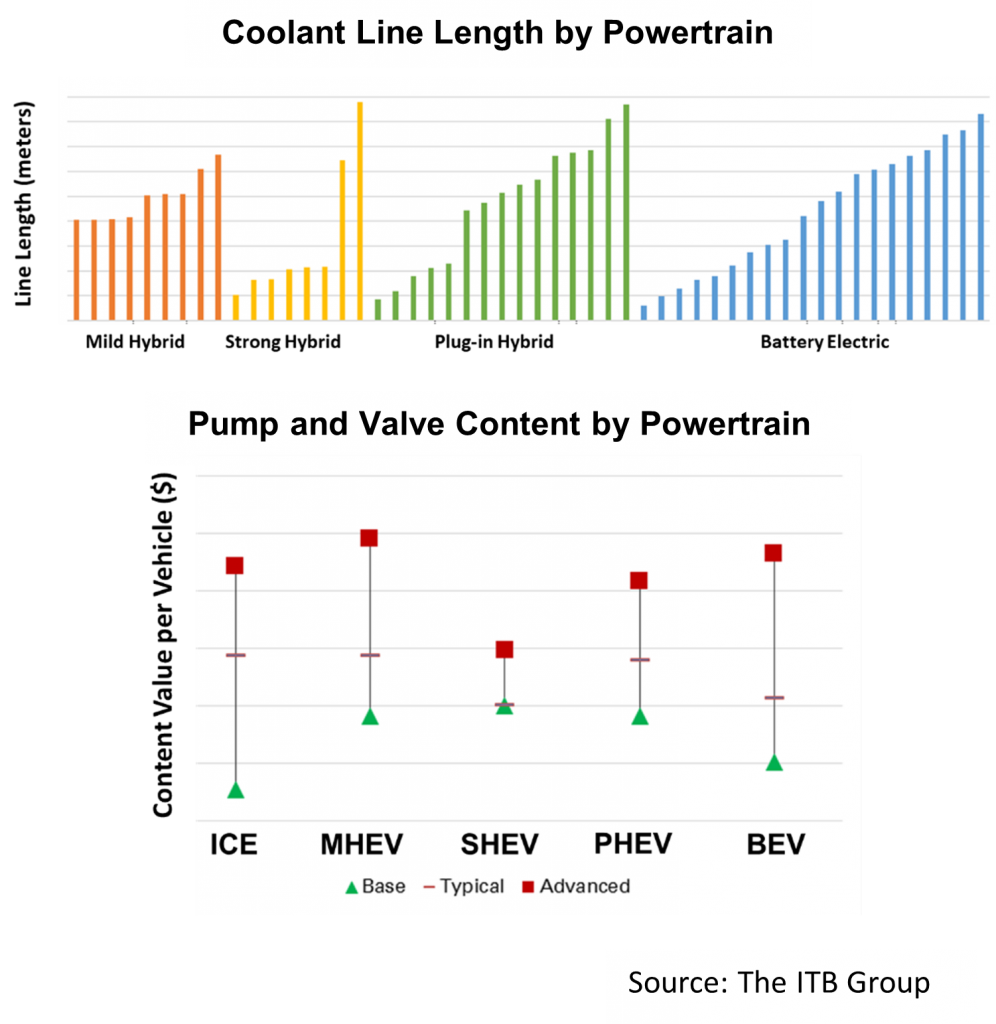Fluid Control and Conveyance Changes as Vehicles Are Electrified
Electrified vehicles have significant coolant, refrigerant, and oil system content. ITB estimates that fluid system market growth will be in the 5-10% range over the next ten years, but individual component sub-segment growth may range from -20% to +20%. Fluid content and growth rates can vary greatly from one OEM to another as well as by powertrain type, and the global region.
ITB’s fluid system research investigates technology developments underpinning these market developments. The technological changes involve fluid control (pumps and valves) as well as fluid conveyance (lines, manifolds, connections, and modules). Additionally, software logic developments are necessary to unlock the potential of new fluid components and architectures.
Fluid System Developments Can Have High Value
Fluid control improvements can improve vehicle value which consumers notice. For example, reducing CO2 emissions, improving vehicle range, and reducing battery charging time. New fluid component and system designs can reduce cost, mass, and package volume to further improve fluid system value propositions and vehicle performance. Material innovations support new designs and functional integration.
Fluid control content may be higher for electrified vehicles than conventional vehicles. This is most pronounced for hybrid vehicle designs, but even BEVs that include heat pumps can have high levels of fluid system content. A high fluid content BEV can have over 40 meters of coolant lines and $400 of pump and valve content!

New Fluid System Innovations are Necessary and Under Development
Transitioning toward battery electric vehicles increases the importance of coolant and refrigerant developments as well as new oil system content. Coolant systems are currently the backbone for capturing and reusing or expelling waste heat from electric machines, power electronics, and most batteries. Refrigerant systems may provide additional heat pump functionality and to do so requires significant additional fluid system components. Oil systems are standard for gearboxes and common for electric machines of BEVs today. Dielectric fluids are being commercialized for a few battery applications over the next several years, with longer-term developments underway for batteries and power electronic applications.
Fluid system content increases must be managed, and ITB foresees future developments to minimize fluid content while maintaining electrified vehicle functions. For example, the trend toward thermal fluid system integration is clear, but the exact path is not. Tesla has set the bar for battery electric vehicle thermal system integration with a heat pump module design. A compact design with nested refrigerant and coolant manifolds plus direct mount pumps and valves provides a significant cost savings versus other multiple-source heat pump system designs. Furthermore, an integrated design allows more space for the frunk, reduced mass, and fewer tube/hose and fluid connections. Tesla’s design is not the only solution though, ITB’s research shows that companies are making different choices about fluid integration.
The rapid increase in electrified vehicle volume will change the economics of electric powertrains and fluid system developments leading toward lower cost, mass, and package volume in comparison to first-generation designs. Electric drive system integration, battery development, and waste heat recovery are driving changes in fluid system designs. Over the next ten years, ITB expects designs to become more refined and mature compared to the high range of variants found in production today.
ITB Provides Insights into Changing Vehicle Fluid System Technologies and Markets
ITB surveys OEMs and companies throughout the automotive value chain to understand unmet needs and new innovations for improved value. In our 2022 research, ITB will be diving deeply into designs and materials for fluid architectures, pumps, valves, lines, manifolds, and fluid connections. This will include differences across global regions, vehicle powertrain types, and OEMs. Contact The ITB Group to learn more about changing technology markets and to influence fluid systems research.


